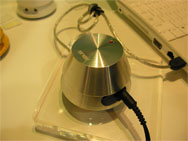Computex 2007: MSI, VIA, and ASUS
Computex 2007: New ASUS Products
Aside from its vast array of new motherboard offerings, ASUS was showing off its new line of Xonar audio products. The first we looked at was the Xonar U1 Audio Station, essentially an external digital sound card that connects to your PC via USB. The Xonar U1 Audio Station uses a toned down version of the AV200 audio chip that the PCI Express and PCI versions of the Xonar line use, and integrates the same sound-enhancing technologies from Dolby and DTS, just in an external solution. A problem common among many notebook users is that the integrated audio on their notebooks simply isn’t loud enough, especially when traveling or on an airplane. We tested the U1 Audio Station at the ASUS booth and were impressed by the crisp and loud quality of the sound we heard from the audio station, it almost completely drowned out the dozen or so people chatting all around us.
There are two versions of the desktop Xonar audio card, the Xonar D2X, a PCI Express x1 variant, and the Xonar D2, a standard PCI version. As mentioned earlier, the Xonar line is a 7.1 channel audio card that brings technology like Dolby Digital Live, Dolby Headphone, Dolby Virtual Speaker, Dolby Pro Logic Ilx, and DTS Interactive to the table. All of these technologies are designed to enhance the audio in your system. Also on display was the ASUS EN8600GT OC GEAR, a GeForce 8600GT based PCI Express graphics card comes with a 5.25” dongle that allows for on the fly graphic card overclocking (up to 30%) and temperature / voltage monitoring.
ASUS was also showing off their new C90 notebook, a notebook that they have said is the market’s “first, true enthusiast friendly DIY notebook”. ASUS is aiming to reach out to enthusiasts by offering them the ability to actually upgrade the C90 in the future, allowing end users to easily swap out the CPU, optical drives, and graphics chip. While inspecting the machine, we asked ASUS to show us how an upgrade would work.
First things first, we had to do was take the C90’s back panel off. If you’ve ever tried upgrading or fixing a notebook over the last few years, you probably know that taking off the notebook’s bottom panel is usually the hardest part. OEM’s often have complex back panel notebook designs, use very small screws, and require you to open the back panel in separate parts: one part to install your memory modules, one to install your CPU, another for your wireless card, etc. The C90 is the first notebook we’ve seen that gives you access to all of the components inside your notebook after simply unscrewing four standard sized screws. ASUS is calling this easy access back panel the ACE door (Accessible, Convenient, Effortless).
Once we had the back panel taken off, we were able to take a closer look at the inside of the C90. As you can see, the C90 actually uses a desktop Intel Core 2 Duo CPU, that along with the NVIDIA GeForce Go 8600 MXM module, is connected to a huge heatsink with four small fans. Because of the large cooling unit on the C90, ASUS is guaranteeing CPU overclocks of at least 20% on the C90. The notebook will ship with overclocking software so that all overclocking can be done from within Windows.
Lastly we have to talk about the notebook’s MXM graphics modules, which were first introduced over three years ago. MXM promised to provide full graphics upgradeability to notebook users, but in reality, due to the proprietary design nature of most notebooks, no one has really tried a fully user-upgradeable notebook. Another key problem has been that MXM modules simply haven’t been available to purchase anywhere, so even when a new graphics chip came out, you couldn’t go out, buy it, and put it in your notebook. ASUS is adamant about future support for the C90, and although they haven’t said exactly how they will offer future MXM graphics chips to end users, the company promised that they would.
ASUS was also showing off a completely new product category, Internet Radio appliances. The company had two models, the AIR2 (ASUS Internet Radio) and the AIR3 on display, and both work on the same, simple concept. The radios have over ten thousand terrestrial radio stations all over the world programmed into memory, and once connected through the internet via either wireless 802.11g or 10/100 Ethernet, AIR connects to the station’s online feed and almost immediately you start hearing your radio station. We listened to radio stations from
And finally we took a look some rather interesting concept design notebooks with an exterior made from bamboo. There was even a notebook that had built in audio mixing equipment. Close by ASUS was also showing off a new 22” LCD monitor that featured its own subwoofer and loud built in speakers.
































